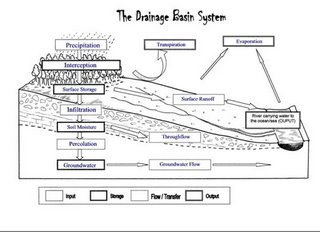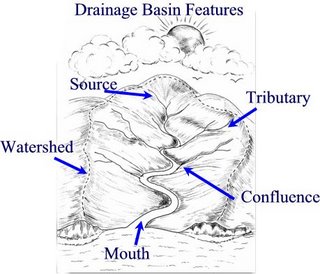Hydrographs and River Discharge
What are Hydrographs? The amount of water in a river at any given point and time is known as the discharge which is measured in cumecs (cubic metres per second). This can be calculated by multiplying river velocity by channel volume at a given point and time. Hydrographs are graphs which show river discharge over a given period of time and show the response of a drainage basin and its river to a period of rainfall. A storm hydrograph shows how a river's discharge responds following a period of heavy rainfall. On a hydrograph, the flood is shown as a peak above the base (normal) flow of the river. Analysis of hydrographs can help hydrologists to predict the likelihood of flooding in a drainage basin. The response of a river to a rainfall event can be measured in terms of the lag time - the time between peak rainfall and peak discharge. Rivers with a short lag time respond rapidly to rainfall events and are therefore more prone to flooding than rivers with a longer lag time River discharge does not respond immediately to rainfall inputs as only a little of the rainfall will fall directly into the channel. The river will start to respond initially through inputs from surface runoff (the fastest flow of water) and its discharge will later be supplemented through inputs from throughflow and groundwater flow. Variations in the shape of a Hydrograph: The shape of a hydrograph is determined by the speed in which flood waters are able to reach the river. The nature of the drainage basin therefore has a great influence on the way a river responds to a river as it will determine the types and speeds of the flow of water to the river. The fastest route to the river is via overland flow. If most of the water in a drainage basin travels in this way, a river will respond quickly to heavy rainfall and the hydrograph shape will be 'peaky' (graph A) with steep rising and recessional limbs. The lag time will be short and there will be a greater risk of flooding. Where more water is able to pass into the soil and travel to the river via throughflow / groundwater flow, there will be a slower rise in discharge and the river will respond slower (graph B). The lag time will be longer and the risk of flooding will be much lower. 

Characteristics of the Drainage Basin:
- - impermeable rocks (e.g. granite) and soil (e.g. clay) will not allow water to pass through, resulting in large amounts of surface runoff and a greater flood risk as rivers respond quickly - results in a short lag time.
- - permeable rocks and soil have a high infiltration capacity and will absorb water quickly, reducing overland flow - results in a longer lag time
- - a drainage basin with a steep gradient will result in greater overland flow and a shorter lag time than where the gradient is less steep allowing more time for infiltration to occur.
Type and amount of Precipitation:

- - heavy rain results in rapid saturation of the upper soil layers and the excess water therefore reaches streams quickly as surface runoff (short lag time)
- - slow light rain can be absorbed by infiltration and the river takes longer to respond to rainfall as water takes longer to pass through the drainage basin via throughflow and groundwater flow (longer lag time)
Land Use and Human Impact

- - impermeable man made surfaces such as concrete and tarmac are impermeable therefore rivers in urban drainage basins tend to have short lag times due to higher amounts of surface runoff and drainage systems taking water to rivers quickly.
- - vegetated areas help to reduce flood risk by increasing the time it takes for water to reach a river (longer lag time) by encouraging infiltration (roots opening up the soil), intercepting water by their leaves and taking up water in their roots.
- - areas cleared by deforestation will respond quickly to rainfall due to the reduced interception
- - Large Drainage Basin - water will take longer to reach the river (long lag time)
- - Small Drainage Basin - water will enter the river quicker (short lag time)
- - If the soil has already been saturated by heavy rain its infiltration capacity will be reduced and further rain will go as surface runoff
- - If the soil is dry it will be able to absorb more water during infiltration and therefore the lag time will be longer
- - if the ground surface is frozen lag time is short as water cannot infiltrates and passes quickly to the river as runoff
River Management

- - the presence of a dam will allow flow to be controlled, reducing flood risk and allowing rivers to gradually respond to heavy rainfall in a controlled way;
Follow up links:
Try out this fantastic interactive module on hydrographs and flooding - learn about how discharge is calculated and watch the animated development of a hydrograph during a virtual rainfall event. Make sure you also try out the flood model - change the land-use in the virtual drainage basin and watch what happens to the rivers discharge and associated hydrograph when you 'flood' the basin!
GCSE Bitesize Revision - Flood hydrographs
Here is a fantastic powerpoint to remind you of how hydrographs are constructed and the factors that affect them - great for revision! Many thanks to Ollie Bray of Mussleburgh Grammar School for sharing this! (If you do not have powerpoint on your computer you can download a free powerpoint viewer here which will then let you view the file)
Revision / Exam Tips:
- make sure you are able to calculate lag time - you may be given a hydrograph in an exam and be expected to give the lag time
- when quoting lag time, discharge, rainfall etc.. from a hydrograph make sure you include the relevant units in your answer! (i.e. hours, cumecs, mm etc.)
- make sure you are able to discuss the factors that result in long or short lag times and thus affect the likelihood of a drainage basin flooding.
Key Terms Check:
Velocity - speed of a river (measured in metres per second)
Hydrograph - a graph showing changes in river discharge over time in response to a rainfall event.
Lag time - the time taken between peak rainfall and peak discharge
Rising Limb - shows the increase in discharge on a hydrograph
Falling Limb - shows the return of discharge to normal / base flow on a hydrograph
Peak Rainfall - maximum rainfall (mm)
Peak Discharge - maximum discharge (cumecs)
























